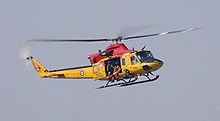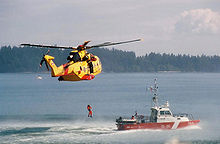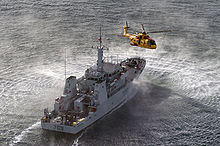- National Search and Rescue Program
-
Canadian Forces CC-115 Buffalo fixed wing SAR aircraft from 442 Transport and Rescue Squadron. All Buffalo aircraft in the CF are located at CFB Comox and are tasked exclusively by JRCC Victoria.

 A Canadian Forces CH-146 Griffon helicopter in SAR paint scheme. From their acquisition by the CF in 1995 until 2005, the only Griffons used for SAR were in "combat support squadrons" at major air force bases to provide SAR support in the event of the loss of another CF aircraft. Combat support squadrons flying the Griffon are located at CFB Cold Lake, CFB Bagotville and CFB Goose Bay. In 2005 424 Transport and Rescue Squadron at CFB Trenton re-equipped with the Griffon to replace its fleet of CH-149 Cormorants as a primary SAR helicopter for central Canada.
A Canadian Forces CH-146 Griffon helicopter in SAR paint scheme. From their acquisition by the CF in 1995 until 2005, the only Griffons used for SAR were in "combat support squadrons" at major air force bases to provide SAR support in the event of the loss of another CF aircraft. Combat support squadrons flying the Griffon are located at CFB Cold Lake, CFB Bagotville and CFB Goose Bay. In 2005 424 Transport and Rescue Squadron at CFB Trenton re-equipped with the Griffon to replace its fleet of CH-149 Cormorants as a primary SAR helicopter for central Canada.
The National Search and Rescue Program (NSP) is the name given by the Government of Canada to the collective search and rescue (SAR) activities in Canada. The NSP is administered by the National Search and Rescue Secretariat (NSS) and it provides for the coordination of public policy for the provision of SAR services.
The primary goal of the NSP is to save lives at risk throughout Canada. This national program involves federal departments, volunteers, organizations, municipalities, provinces and territories, working together to provide this service.
Contents
Organizational structure
The Lead Minister for Search and Rescue (LMSAR) in the Government of Canada is the Minister of National Defence. Responsibilities are broken down within the federal government as follows:
- The Department of National Defence is the lead ministry responsible for providing and coordinating SAR response for incidents involving aircraft, and incidents involving vessels in federal or international waters. This is accomplished through the air force, which operates 3 Joint Rescue Coordination Centres (JRCCs) as well as various dedicated SAR squadrons of helicopters and fixed-wing aircraft.
- The Department of Fisheries and Oceans, through the Canadian Coast Guard, is tasked with responding to emergencies involving vessels that occur in waters of federal responsibilitiy (all ocean waters on Canada's 3 coasts, plus the Great Lakes, St. Lawrence River, and portions of connecting waterways). Coast Guard personnel also help Canadian Forces personnel staff the 3 JRCCs and they exclusively staff 2 Maritime Rescue Sub-Centres (MRSCs).
- The Department of Transport, through its civil aviation and marine safety programs, works to prevent air and marine incidents requiring a search and rescue response. This is accomplished through its regulation, inspection, enforcement, and safety promotion functions.
The three JRCCs are:
- Joint Rescue Coordination Centre Halifax (JRCC Halifax)
- Joint Rescue Coordination Centre Trenton (JRCC Trenton)
- Joint Rescue Coordination Centre Victoria (JRCC Victoria)
The two MRSCs are:
- Maritime Rescue Sub-Centre Quebec (MRSC Quebec)
- Maritime Rescue Sub-Centre St. John's (MRSC St. John's)
Operations
Provision of SAR services in Canada is broken down as follows:
Air Resources
The Royal Canadian Air Force and CASARA (Civil Air Search And Rescue Association) provide air resources for SAR incidents under federal jurisdiction. This includes:
- Any aircraft incident within Canada's SAR region of responsibility, regardless of whether the incident occurs over land or water.
- A marine incident that occurs within waters under federal jurisdiction.
- The Canadian Forces and/or CASARA may also be tasked to assist with a ground search and rescue incident, or a marine incident occurring in non-federal (i.e. inland) waters, if requested by the provincial or territorial search and rescue authority. In some jurisdictions, CASARA has established independent agreements with provincial governments to provide air support to ground searches, independent of the federal search and rescue system.
Primary Canadian Forces Search and Rescue squadrons are stationed at CFB Gander, CFB Greenwood, CFB Trenton, CFB Winnipeg, and CFB Comox. Combat support squadrons are also located at CFB Cold Lake, CFB Bagotville, and CFB Goose Bay.
Marine Resources
The Canadian Coast Guard and the Canadian Coast Guard Auxiliary provide primary marine resources in waters under federal jurisdiction.
On inland waters, many police services and fire departments operate patrol and rescue vessels that are used to respond to search and rescue incidents. Some ground search and rescue volunteer teams also operate their own watercraft in support of search and rescue, such as British Columbia's Kent Harrison Search and Rescue.
Other volunteer marine search and rescue organizations provide specialty services to local communities and other government agencies. These include:
Ground and Inland Waters Resources
- Parks Canada provides search and rescue services within national parks, national marine conservation areas, national park reserves, national historic sites and historic canals.
- Outside national parks, the police force having jurisdiction responds to SAR incidents. In most of rural Canada, and some urban areas this is the Royal Canadian Mounted Police (RCMP) (except Ontario, Quebec, and parts of Newfoundland and Labrador).
- The Ontario Provincial Police, Sûreté du Québec, and Royal Newfoundland Constabulary respond to SAR incidents in Ontario, Quebec, and parts of Newfoundland and Labrador respectively.
- There are also over 260 municipal police forces who are responsible for search and rescue within their jurisdictions, including large cities such as Toronto, Vancouver, Montreal, and London. Search and rescue in urban areas is also supported by municipal fire departments, many of whom operate high-angle and swiftwater rescue teams to cover the river valleys, bluffs, and ravines found in many cities. Teams specializing in the rescue of persons from collapsed structures and other entrapments (Heavy Urban Search and Rescue) are also being formed in major urban centres across Canada. See HUSAR and Toronto Police Marine unit.
- Volunteer search and rescue organizations frequently assist the primary police agency responding by providing the large amount of manpower necessary for a search, as well as specialized expertise, equipment, and local knowledge. The Search and Rescue Volunteer Association of Canada (SARVAC) is the national body representing ground and inland water SAR volunteers in Canada.
National SAR Secretariat
Following the Ocean Ranger disaster, one of the key recommendations resulting from the Royal Commission of Inquiry was that a national coordinating authority be established.
The National Search and Rescue Secretariat (NSS) is an independent agency of government, reporting to the LMSAR, and supports and promotes the activities of the National SAR Program (NSP) as a means to achieve highly effective and economically responsible search and rescue programs throughout Canada.
Provincial/Territorial Breakdown
In addition to the federal air and marine elements of the National Search and Rescue Program, each province and territory has developed its own Emergency Management programs to facilitate ground and inland water search and rescue within their jurisdictions. The police, aided by trained volunteers, respond to SAR incidents in the provinces and territories. Mutual aid is common, however, between all partners in the National Search and Rescue Program.
British Columbia
The British Columbia Provincial Emergency Program, under the Ministry of Public Safety and Solicitor General, coordinates volunteer ground and inland water search and rescue throughout the province. Local police, including the RCMP, are the main organizations responsible for responding to requests for ground and inland water SAR, with volunteer groups providing support for their local detachment. Civilian volunteer search and rescue is represented by the BC Search and Rescue Association, which represents the 93 registered search and rescue teams in the province.
Alberta
Emergency Management Alberta is responsible for disaster management and preparedness for the province of Alberta. Their civilian volunteer organization is SAR Alberta
Saskatchewan
Saskatchewan Emergency Management Organization (SaskEMO) coordinates provincial government resources in support of ground search and rescue activities. Under a contract with the province, the RCMP is the primary organization responding to requests for ground and inland water SAR in Saskatchewan. The Search and Rescue Saskatchewan Association of Volunteers represents the 21 civilian teams in the province.
Manitoba
Manitoba has the Manitoba Emergency Measures Organization MEMO. In partnership with RCMP "D" Division, the Office of the Fire Commissioner has worked to create and support SAR networks in the province including 29 teams of trained volunteers.
Ontario
The Ontario Provincial Police is responsible for security and public safety in the province. This includes land and inland water search and rescue activities in Ontario. Ground SAR coordination is promoted through the Ontario SAR Advisory Council and carried out through Emergency Management Ontario. A number of volunteer organizations in the province provide SAR support to the OPP when requested. These teams are organized under the Ontario Search and Rescue Volunteer Association (OSARVA), which is responsible for co-ordinating training and standards between the volunteer units, with oversight and accreditation coming from the OPP. Also within Ontario, volunteer SAR units are becoming specialized divisions within St. John Ambulance, leading to a more precise training structure, and cohesion and interoperability province-wide. The starting foundation for this unique implementation has been spearheaded with the London Search And Rescue Team also known as Division 1182 of St John Ambulance.
Quebec
The Sûreté du Québec (Direction des mesures d'urgence) is the primary organization providing ground and inland water search and rescue services in Québec, under the authority of the Ministère de la Sûreté publique. Québec also has a civil volunteer association called Association Quebeçoise des Bénévoles en Recherche et Sauvetage.
New Brunswick
The provincial Department of Municipalities, Culture and Housing is responsible for providing ground search and rescue services throughout the province through the Emergency Measures Organization. New Brunswick is divided into 12 zones, each with an official volunteer ground SAR team, trained and organized by the New Brunswick Ground Search and Rescue Association
Prince Edward Island
The Emergency Measures Organization coordinates provincial government resources in support of ground search and rescue services. Under contract with the province, the RCMP, as the provincial police force, responds to requests for ground and inland water SAR in Prince Edward Island but is assisted by the Prince Edward Island Ground Search and Rescue Association.
Nova Scotia
The Government of Nova Scotia, with the assistance of the Emergency Measures Organization, leads search and rescue programs for the province. The civilian volunteer association is the Nova Scotia Ground Search and Rescue Association. Under contract with the provincial Department of the Solicitor General, local police forces, including the RCMP, coordinate and assign resources as required. The EMO has an agreement to provide assistance to local police forces by providing air SAR support when required.
Newfoundland and Labrador
The responsibility for responding to requests for ground and inland water search and rescue in Newfoundland is shared by the RCMP and the Royal Newfoundland Constabulary. Additional support is provided by volunteer teams tasked and trained by either the RCMP or RNC, depending on the jurisdiction. All provincial volunteer SAR teams are members of the Newfoundland and Labrador Search and Rescue Association, and registered with the Emergency Measures Organization, which represents the provincial Department of Municipal and Provincial Affairs.
Yukon
The Emergency Measures Organization coordinates the use of territorial government resources in support of search and rescue through the Emergency Measures Branch of the Yukon government. The EMO also recruits volunteers and trains volunteer organizations in mountain and cliff rescues, as well as in other SAR techniques. The EMO has established permanent ground SAR societies in communities across the Yukon. These societies exist as independent organizations, have written agreements with the EMO, and are registered under the Societies Act. The RCMP, as the territorial police force, is the primary organization responding to requests for ground and inland water SAR in the Yukon. Each volunteer group is tasked by the RCMP and provides support to their local detachment.
The territorial government of Nunavut is responsible for providing search and rescue services on land and inland waters through the RCMP. The Government of Nunavut has mandated the RCMP to respond to requests for ground and inland water SAR in the territory. Because of the vast size of Nunavut, with a small and widely distributed population, some SAR emergencies are handled by local authorities as well as trained community volunteer teams.
Northwest Territories
The government of the Northwest Territories maintains the Emergency Management Organization, and much like Nunavut, are served by a number of Emergency Management Organizations distributed at the population centres in the territory.
External links
References
Categories:
Wikimedia Foundation. 2010.



